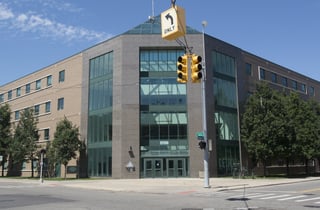In 2015, Wayne State University’s Academic Administration Building, Detroit, MI, was facing many of the same concerns as other office buildings of similar age. Tenants (in this case University employees) repeatedly complained to building maintenance staff that they were “too hot” or “too cold.” And the costs of running the building kept creeping up.
As part of a DTE Energy and Nexant Retro-commissioning (RCx) project for no-cost and low-cost energy conservation measures (ECMs) with short-term payback, Newman Consulting Group (NCG) conducted an ASHRAE Level 2 Energy Analysis and RCx Study on the building. We uncovered several opportunities that would not only make tenants more comfortable, but also save money. The DTE RCx program, however, dictated that any measures eligible for rebates from DTE under their Energy Optimization program could not be included in the ECMs implemented for this project, e.g., LED lighting, high-efficiency motors, or VFDs, to name a few. Still, we were able to make significant improvements.
 About the Building:
About the Building:
A 4-story, steel-framed office building built in 1995, the AAB houses offices, conference rooms and training areas and is generally occupied 8 a.m. to 5 p.m., Monday through Friday. The rectangular structure has concrete curtain walls, a window area of approximately 10%, and a flat roof. A vaulted atrium greets visitors entering the building. All 131,000 SF within the building are conditioned. The AAB is essentially an all air system building, with a single VAV air handler unit (AHU) with Variable Speed Drive serving each floor. A Centralized Building Automation System (BAS) controls the major HVAC equipment.
Strategies and Results:
The three greatest opportunities for savings involved adjusting the mixed air dampers, shifting the economizer setpoint, and optimizing the AHU schedules. Together, these measures realized an estimated savings of more than $20,000 per year after just a $5,000 investment. In terms of simple payback, the University would recoup its investment in just a few months, while continuing to save money for many years down the road. For details on how much energy and money we saved, see the Project Profile here.
- Adjust Mixed Air Dampers
As often happens in older buildings, none of the mixed air economizer dampers were functioning properly. Due to corrosion, damage, etc., they were either not fully opening or closing, or not working at all. The first step was to fix the dampers so they worked as designed, were properly responsive to the Building Automation System (BAS), and allowed in only the proper amount of outside air to meet code and keep personnel comfortable without causing indoor temperatures to fluctuate too much. At nearly $4,000, this was the most costly of the ECMs implemented. The savings for both gas and electrical totaled more than $4,500 in the first year so simple payback of less than a year was definitely worth it. - Shift Economizer Setpoint
Once the dampers were fixed, we changed their setpoint, moving it up to 65◦ This meant the dampers would respond only when necessary, as dictated by the BAS (see #3) to keep the inside temperature comfortable. Implementation cost was just $400, and first year electrical savings was more than $800. - Set Proper AHU Schedules
Because the economizer dampers were not working properly, the only way to keep the building temperature comfortable in cold weather while supplying enough outside air was to run the system almost 24/7. Clearly this was not optimal, especially since so much cold outside air was brought in at night when the building was unoccupied and the AHUs had to work extra hard to maintain habitable temperatures.
Once the dampers were fixed and the mixed air setpoint was adjusted we were able to reprogram the BAS so the AHUs ran only when people were in the building, typically 8 a.m. to 5 p.m., Monday through Friday. Again the implementation cost was just around $400, but the payback for gas and electrical savings was more than $15,000/year!
After the retrofits were completed, we conducted two weeks of measurement and verification (M & V) using the BAS and trending information to ensure everything was operating properly and our savings estimates were being met. In reality, the savings were somewhat greater than we had anticipated. The building occupants were a whole lot happier as were the building engineers and maintenance personnel, not to mention the V.P. of Finance.
For more information to or to see if you qualify for the DTE RCx program that includes a free energy audit, contact Newman Consulting Group.



